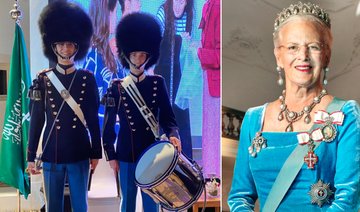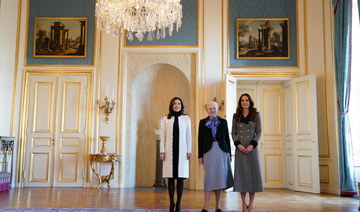COPENHAGEN: Denmark’s prime minister proclaimed Frederik X as king on Sunday after his mother Queen Margrethe II formally signed her abdication, with massive crowds turning out to rejoice in the throne passing from a beloved monarch to her popular son.
Margrethe, 83, is the first Danish monarch to voluntarily relinquish the throne in nearly 900 years. Many thousands of people gathered outside the palace where the royal succession took place, the mood jubilant as the Nordic nation experienced its first royal succession in more than a half-century, and one not caused by the death of a monarch.
Denmark’s monarchy traces its origins to 10th-century Viking king Gorm the Old, making it the oldest in Europe and one of the oldest in the world. Today the royal family’s duties are largely ceremonial.
Margrethe signed her abdication during a meeting with the government at the Christiansborg Palace, a vast complex in Copenhagen that has been the seat of Danish power for centuries. It now houses the Royal Reception Rooms and Royal Stables as well as the Danish Parliament, the prime minister’s office and the Supreme Court.
Prime Minister Mette Frederiksen next proclaimed Frederik king from the balcony of the palace before the cheering crowd.
Frederiksen read the proclamation three times, which is the tradition, as Frederik stood beside her wearing a ceremonial military uniform adorned with medals. He was then joined on the balcony by the new, Australian-born Queen Mary and the couple’s four children, and the crowd spontaneously sang the national anthem.
“My hope is to become a unifying king of tomorrow,” Frederik said. “It is a task I have approached all my life.”
It is the custom for each new sovereign to adopt a royal motto as a guiding principle for their reign, and Frederik’s is: “United, committed, for the kingdom of Denmark.”
“I want to return the trust I meet,” the new king said. “I need trust from my beloved wife, you and that which is greater than us.”
Frederik kissed Mary, the queen, who wore a white dress with a sash over one shoulder, and another great cheer rose from the crowd.
They then left Christianborg Palace in a horse-drawn coach as church bells rang out, and headed to their Amalienborg residence, where they once again appeared before people cheering and waving the nation’s flag of a white cross on a red background.
Frederik, who was visibly moved, placed both hands on his heart in a gesture of thanks.
The abdication document was earlier presented to Margrethe as she sat at a massive table covered in red cloth around which royals and members of the Danish government were seated. Frederik sat beside her.
After signing it, Margrethe, dressed in a magenta skirt suit, rose and gestured to Frederik to take her place. “God save the king,” she said as she left the room using a cane for support.
The abdication leaves Denmark with two queens: Margrethe keeps her title, while Frederik’s wife becomes Queen Mary. Frederik and Mary’s eldest son Christian, 18, has become crown prince and heir to the throne.
Citing health issues, Margrethe announced on New Year’s Eve that she would step down, stunning a nation that had expected her to live out her days on the throne, as is the tradition in the Danish monarchy. Margrethe underwent major back surgery last February and didn’t return to work until April.
Even the prime minister was unaware of the queen’s intentions until right before the announcement. Margrethe had informed Frederik and his younger brother Joachim just three days earlier, the Berlingske newspaper wrote, citing the royal palace.
People from across Denmark gathered outside parliament, with many swarming streets decorated with red-and-white Danish flags. Several shops hung photos of Margrethe and Frederik, while city buses were adorned with small Danish flags as is customary during royal events. Many others across the kingdom of nearly 6 million people followed a live television broadcast of the historic event.
“It was worth the four hours wait,” said Anders Pejtersen, 25. He made the trip from Aalborg, in northern Denmark, to witness Frederik’s proclamation. His mother, Helle Pejtersen, said “it was intense.”
Marina Gregovic, 32, a Copenhagen resident, said she believed Frederik “will be fantastic. And we loved his speech.”
Royals across Europe sent their congratulations including UK King Charles III, whose late mother Queen Elizabeth II and Margrethe were third cousins.
Charles said he was committed to working with them “on ensuring that the enduring bond between our countries, and our families, remains strong.”
Earlier in the day, the royal guards’ music band made their daily parade through downtown Copenhagen, but wore the red jackets used to mark major events, instead of their usual black.
The last time a Danish monarch voluntarily resigned was in 1146, when King Erik III Lam stepped down to enter a monastery. Margrethe abdicated on the same day of January that she ascended the throne following the death of her father, King Frederik IX, on Jan. 14, 1972.
Australians also turned out on the streets of Copenhagen to celebrate one of their own becoming queen.
“I think it’s good that she’s not from royalty and has a normal Australian background. We can relate more to that, because she’s from a middle-class background, and we are too,” said Judy Langtree, who made the long journey from Brisbane with her daughter to witness the royal event.
A survey — commissioned by Denmark’s public broadcaster DR — published Friday showed that 79 percent of the 1,037 people polled by the Epinion polling institute said that they believed Frederik was prepared to take the reigns and 83 percent said they thought his wife Mary was ready to become queen. The survey margin of error was 3 percentage points, DR said.
Though a hereditary monarchy might seem contradictory to the egalitarian principles of modern-day Denmark, the royal family remains highly popular and the anti-monarchist movement is small.
“The republicans in Denmark have no future,” former parliamentary Speaker Pia Kjærsgaard said on public television.
Frederik X is proclaimed king of Denmark after his mother Queen Margrethe II abdicates
https://arab.news/mcj4v
Frederik X is proclaimed king of Denmark after his mother Queen Margrethe II abdicates

- Margrethe, 83, is the first Danish monarch to voluntarily relinquish the throne in nearly 900 years
- Prime Minister Mette Frederiksen proclaimed Frederik king from the balcony of the royal palace before the cheering crowd
- Denmark’s monarchy traces its origins to 10th-century Viking king Gorm the Old
A 98-year-old in Ukraine walked miles to safety from Russians, with slippers and a cane

- Describing her journey, the nonagenarian said she had fallen twice and was forced to stop to rest at some points, even sleeping along the way before waking up and continuing her journey
KYIV, Ukraine: A 98-year-old woman in Ukraine who escaped Russian-occupied territory by walking almost 10 kilometers (6 miles) alone, wearing a pair of slippers and supported by a cane has been reunited with her family days after they were separated while fleeing to safety.
Lidia Stepanivna Lomikovska and her family decided to leave the frontline town of Ocheretyne, in the eastern Donetsk region, last week after Russian troops entered it and fighting intensified.
Russians have been advancing in the area, pounding Kyiv’s depleted, ammunition-deprived forces with artillery, drones and bombs.
“I woke up surrounded by shooting all around — so scary,” Lomikovska said in a video interview posted by the National Police of Donetsk region.
In the chaos of the departure, Lomikovska became separated from her son and two daughters-in-law, including one, Olha Lomikovska, injured by shrapnel days earlier. The younger family members took to back routes, but Lydia wanted to stay on the main road.
With a cane in one hand and steadying herself using a splintered piece of wood in the other, the pensioner walked all day without food and water to reach Ukrainian lines.
Describing her journey, the nonagenarian said she had fallen twice and was forced to stop to rest at some points, even sleeping along the way before waking up and continuing her journey.
“Once I lost balance and fell into weeds. I fell asleep … a little, and continued walking. And then, for the second time, again, I fell. But then I got up and thought to myself: “I need to keep walking, bit by bit,’” Lomikovska said.
Pavlo Diachenko, acting spokesman for the National Police of Ukraine in the Donetsk region, said Lomikovska was saved when Ukrainian soldiers spotted her walking along the road in the evening. They handed her over to the “White Angels,” a police group that evacuates citizens living on the front line, who then took her to a shelter for evacuees and contacted her relatives.
“I survived that war,’ she said referring to World War II. “I had to go through this war too, and in the end, I am left with nothing.
“That war wasn’t like this one. I saw that war. Not a single house burned down. But now – everything is on fire,” she said to her rescuer.
In the latest twist to the story, the chief executive of one of Ukraine’s largest banks announced on his Telegram channel Tuesday that the bank would purchase a house for the pensioner.
“Monobank will buy Lydia Stepanivna a house and she will surely live in it until the moment when this abomination disappears from our land,” Oleh Horokhovskyi said.
Amazon Purr-rime: Cat accidentally shipped to online retailer

- Galena was found safe by a warehouse worker at an Amazon center after vanishing from her home in Utah
LOS ANGELES: A curious cat that sneaked into an open box was shipped across the United States to an Amazon warehouse after its unknowing owners sealed it inside.
Carrie Clark’s pet, Galena, vanished from her Utah home on April 10, sparking a furious search that involved plastering “missing” posters around the neighborhood.
But a week later, a vet hundreds of miles (kilometers) away in Los Angeles got in touch to say the cat had been discovered in a box — alongside several pairs of boots — by a warehouse worker at an Amazon center.
“I ran to tell my husband that Galena was found and we broke down upon realizing that she must have jumped into an oversized box that we shipped out the previous Wednesday,” Clark told KSL TV in Salt Lake City.
“The box was a ‘try before you buy,’ and filled with steel-toed work boots.”
Clark and her husband jetted to Los Angeles, where they discovered Amazon employee Brandy Hunter had rescued Galena — a little hungry and thirsty after six days in a cardboard box, but otherwise unharmed.
“I could tell she belonged to someone by the way she was behaving,” said Hunter, according to Amazon.
“I took her home that night and went to the vet the next day to have her checked for a microchip, and the rest is history.”
What did people eat before agriculture? New study offers insight

- Analysis of forms — or isotopes — of elements including carbon, nitrogen, zinc, sulfur and strontium in these remains indicated the type and amount of plants and meat they ate
WASHINGTON: The advent of agriculture roughly 11,500 years ago in the Middle East was a milestone for humankind — a revolution in diet and lifestyle that moved beyond the way hunter-gatherers had existed since Homo sapiens arose more than 300,000 years ago in Africa.
While the scarcity of well-preserved human remains from the period preceding this turning point has made the diet of pre-agricultural people a bit of a mystery, new research is now providing insight into this question. Scientists reconstructed the dietary practices of one such culture from North Africa, surprisingly documenting a heavily plant-based diet.
The researchers examined chemical signatures in bones and teeth from the remains of seven people, as well as various isolated teeth, from about 15,000 years ago found in a cave outside the village of Taforalt in northeastern Morocco. The people were part of what is called the Iberomaurusian culture.
Analysis of forms — or isotopes — of elements including carbon, nitrogen, zinc, sulfur and strontium in these remains indicated the type and amount of plants and meat they ate. Found at the site were remains from different edible wild plants including sweet acorns, pine nuts, pistachio, oats and legumes called pulses. The main prey, based on bones discovered at the cave, was a species called Barbary sheep.
“The prevailing notion has been that hunter-gatherers’ diets were primarily composed of animal proteins. However, the evidence from Taforalt demonstrates that plants constituted a big part of the hunter-gatherers’ menu,” said Zineb Moubtahij, a doctoral student in archaeology at the Max Planck Institute for Evolutionary Anthropology in Germany and lead author of the study published on Monday in the journal Nature Ecology & Evolution.
“It is important as it suggests that possibly several populations in the world already started to include substantial amount of plants in their diet” in the period before agriculture was developed, added archeogeochemist and study co-author Klervia Jaouen of the French research agency CNRS.
The Iberomaurusians were hunter-gatherers who inhabited parts of Morocco and Libya from around 25,000 to 11,000 years ago. Evidence indicates the cave served as a living space and burial site.
These people used the cave for significant portions of each year, suggesting a lifestyle more sedentary than simply roaming the landscape searching for resources, the researchers said. They exploited wild plants that ripened at different seasons of the year, while their dental cavities illustrated a reliance on starchy botanical species.
Edible plants may have been stored by the hunter-gatherers year-round to guard against seasonal shortages of prey and ensure a regular food supply, the researchers said.
These people ate only wild plants, the researchers found. The Iberomaurusians never developed agriculture, which came relatively late to North Africa.
“Interestingly, our findings showed minimal evidence of seafood or freshwater food consumption among these ancient groups. Additionally, it seems that these humans may have introduced wild plants into the diets of their infants at an earlier stage than previously believed,” Moubtahij said.
“Specifically, we focused on the transition from breastfeeding to solid foods in infants. Breast milk has a unique isotopic signature, distinct from the isotopic composition of solid foods typically consumed by adults.”
Two infants were among the seven people whose remains were studied. By comparing the chemical composition of an infant’s tooth, formed during the breastfeeding period, with the composition of bone tissue, which reflects the diet shortly before death, the researchers discerned changes in the baby’s diet over time. The evidence indicated the introduction of solid foods at around the age of 12 months, with babies weaned earlier than expected for a pre-agricultural society.
North Africa is a key region for studying Homo sapiens evolution and dispersal out of Africa.
“Understanding why some hunter-gatherer groups transitioned to agriculture while others did not can provide valuable insights into the drivers of agricultural innovation and the factors that influenced human societies’ decisions to adopt new subsistence strategies,” Moubtahij said.
Palestinian prisoner in Israel wins top fiction prize

- The mask in the novel’s title refers to the blue identity card that Nur, an archaeologist living in a refugee camp in Ramallah, finds in the pocket of an old coat belonging to an Israeli
ABU DHABI: Palestinian writer Basim Khandaqji, jailed 20 years ago in Israel, won a prestigious prize for Arabic fiction on Sunday for his novel “A Mask, the Color of the Sky.”
The award of the 2024 International Prize for Arabic Fiction was announced at a ceremony in Abu Dhabi.
The prize was accepted on Khandaqji’s behalf by Rana Idriss, owner of Dar Al-Adab, the book’s Lebanon-based publisher.
Khandaqji was born in the Israeli-occupied West Bank city of Nablus in 1983, and wrote short stories until his arrest in 2004 at the age of 21.
He was convicted and jailed on charges relating to a deadly bombing in Tel Aviv, and completed his university education from inside jail via the Internet.
The mask in the novel’s title refers to the blue identity card that Nur, an archaeologist living in a refugee camp in Ramallah, finds in the pocket of an old coat belonging to an Israeli.
Khandaqji’s book was chosen from 133 works submitted to the competition.
Nabil Suleiman, who chaired the jury, said the novel “dissects a complex, bitter reality of family fragmentation, displacement, genocide, and racism.”
Since being jailed Khandaqji has written poetry collections including “Rituals of the First Time” and “The Breath of a Nocturnal Poem.”
He has also written three earlier novels.
Mexican doctor claims victory in $28 Cartier earrings battle

MEXICO CITY: A Mexican man has claimed a victory over French luxury brand Cartier, saying an error allowed him to buy two pairs of earrings for $28 that were supposed to cost nearly $28,000.
After a four-month struggle, doctor Rogelio Villarreal said he had finally received the jewelry, which he accused the company of refusing to deliver after his online purchase in December.
According to Villarreal, he came across the low-priced earrings while browsing Instagram.
“I swear I broke out in a cold sweat,” he wrote on the social media platform X.
Cartier declined to recognize the purchase and offered Villarreal a refund, as well as a bottle of champagne and a passport holder as compensation, according to a company letter shared by the doctor.
But Villarreal refused and decided to take the case to Mexico’s consumer protection agency, which ruled in favor of the doctor.
Cartier accepted the decision, Villarreal announced.
“War is over. Cartier is complying,” he wrote.





















